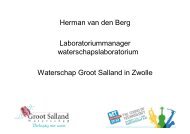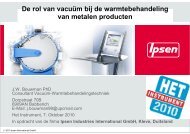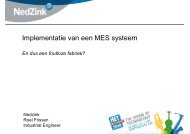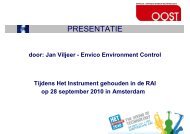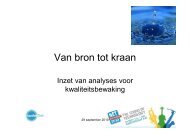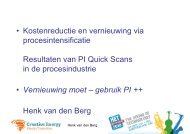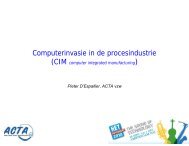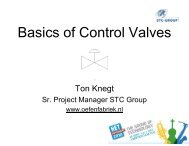PURELAB flex - HET Instrument 2010
PURELAB flex - HET Instrument 2010
PURELAB flex - HET Instrument 2010
You also want an ePaper? Increase the reach of your titles
YUMPU automatically turns print PDFs into web optimized ePapers that Google loves.
Technology Note 18<br />
<strong>PURELAB</strong> <strong>flex</strong><br />
Real Time TOC System<br />
Why do we monitor TOC<br />
Resistivity is well established as a good<br />
indicator of the level of inorganic ionic<br />
impurities in pure water. If the resistivity of<br />
water is greater than 17 MΩ-cm we can be<br />
sure that only a few parts-per-billion (ppb) of<br />
ions can be present. At a resistivity of 1 MΩcm<br />
ionic levels can be as high as 1000ppb.<br />
In the same way, total organic carbon (TOC) is a useful<br />
universal indicator of the presence of organic impurities in<br />
water. By monitoring TOC on-line in real-time, we can be<br />
assured of the overall organic purity of the water.<br />
The overall ionic and organic purity of the water can be<br />
confirmed by monitoring both resistivity and TOC. Logging<br />
these values facilitates the identification of trends and the<br />
detection of changes in system performance.<br />
compounds will vary according to the percentage of carbon in<br />
each contaminant and the effect of other ions in the organic<br />
compound, such as chloride.<br />
Sensitive analysis such as HPLC & GC-MS measures impurities<br />
down to ppb levels of contaminants. Ultra pure water is used<br />
to prepare samples and standards and as a component of the<br />
mobile phase in HPLC. Organic carbon compounds remaining in<br />
the water can therefore have a dramatic effect in the accuracy<br />
and sensitivity of these analyzers.<br />
How is TOC monitored in the <strong>PURELAB</strong> <strong>flex</strong><br />
In a basic on-line TOC monitor the water is measured for<br />
resistivity, oxidized and measured again. The TOC value is a<br />
function of the difference between the resistivity pre and post<br />
oxidization, as shown in Technology Note 7.<br />
As water is dispensed from the <strong>PURELAB</strong> <strong>flex</strong>, the pre-purified<br />
feedwater is pumped through a chamber irradiated with<br />
high-energy UV light. The organic compounds in the water<br />
are oxidized to ionic species which cause the resistivity of the<br />
water to fall. By measuring the change in resistivity caused<br />
by the UV-photo-oxidation the TOC of the product water can<br />
be estimated. The organic ions produced are removed on the<br />
down-stream purification pack. The pack itself is kept clean by<br />
intermittent recirculation of highly purified water.<br />
The oxidative efficiency of the UV lamp is monitored<br />
The limitations of monitoring TOC<br />
periodically to ensure the TOC is measured accurately. When<br />
the oxidative efficiency begins to change the TOC monitor<br />
In the same way that a resistivity monitor cannot specify the<br />
recalibrates itself to ensure that the TOC continues to be<br />
particular inorganic ions in the water, a TOC measurement<br />
measured accurately. When the efficiency falls below the<br />
cannot help us to define which specific organic impurities<br />
recalibration adjustment levels, a UV replacement is indicated.<br />
are present. Furthermore the relationship between the<br />
This ensures that the UV lamp is changed at the right time.<br />
TOC and the equivalent Process Flow concentrations <strong>PURELAB</strong> <strong>flex</strong> of (with various Purification organic Pack, UV and TOC)<br />
Water Purity Sensor<br />
10 MΩ-cm<br />
Photo-oxidization UV<br />
Purification<br />
Pack<br />
Water<br />
Purity<br />
Sensor<br />
Dispense Handset<br />
Feedwater<br />
Inlet<br />
(Pre-purified Water)<br />
Water Purity Sensor<br />
15 MΩ-cm<br />
0.2µm Point of<br />
Use Filter or<br />
Biofilter<br />
(optional)<br />
Pump
Technology Note 18<br />
Advantages of real-time TOC monitoring<br />
The main advantage of real-time TOC monitoring as used in the <strong>PURELAB</strong> <strong>flex</strong> is that the TOC reading you see is the TOC in<br />
the water you are dispensing. Conventional TOC monitors take a sample of water as it is being dispensed and oxidize it over a<br />
period of four to eight minutes before giving a result. During this time the TOC of your water is unknown and when you have a<br />
result you will have long since stopped dispensing water.<br />
As illustrated in the figures, the red trace shows the actual TOC of the water being dispensed. A sudden change of TOC occurs.<br />
The light blue traces from conventional monitors show that they do not detect the change in TOC until many minutes later.<br />
The dark blue trace from the real-time monitor demonstrates its immediate response.<br />
Technology Note 7 describes TOC monitoring of pure water in greater detail.<br />
Advantages of Real-Time TOC Monitoring<br />
250<br />
Period of unknown TOC measurement<br />
200<br />
TOC (ppb)<br />
150<br />
100<br />
50<br />
0<br />
0 2 4 6 8 10<br />
250<br />
Time (mins)<br />
Period of unknown TOC measurement<br />
Conventional monitor<br />
Dispense<br />
Real-time TOC monitor<br />
200<br />
TOC (ppb)<br />
150<br />
100<br />
50<br />
0<br />
0 2 4 6 8 10<br />
Time (mins)<br />
The <strong>PURELAB</strong> <strong>flex</strong> will monitor TOC successfully as long as it is fed with water with resistivity greater than 5 MΩ-cm.<br />
ELGA LabWater<br />
Tel: +44 (0) 1494 887500 Fax: +44 (0) 1494 887505<br />
Email: info@elgalabwater.com Website: www.elgalabwater.com<br />
ELGA® is the global laboratory water brand name of Veolia Water. VWS (UK) Ltd. Registered in England &<br />
Wales No. 327847 ©Copyright 2009 ELGA LabWater/VWS (UK) Ltd. All rights reserved. As part of our policy<br />
of continual improvement we reserve the right to alter the specifications given in this technology note.<br />
Technology Note TN18 September 2009




